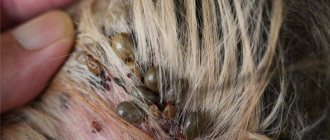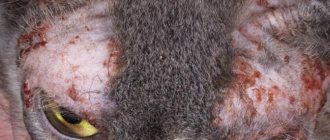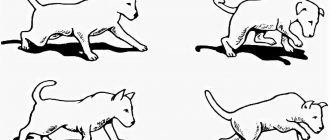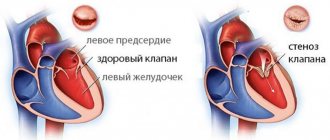Dermatological diseases in animals are among the most complex. It can be problematic to prescribe an adequate treatment regimen, as well as to bring it to its logical conclusion. If in large cities there are veterinary clinics where highly specialized specialists work, there is equipment and laboratories, then in the periphery the situation is much worse. Here, seborrhea in dogs becomes an almost insurmountable disease, which doctors can suppress for a while, after which a new period of exacerbation follows. Today we decided to take a detailed look at this disease, its causes and methods of adequate treatment.
Where do legs come from?
When you first hear the term “seborrhea in dogs,” a person may think that we are talking about basic dandruff. In fact, this phenomenon has much more serious reasons, and it manifests itself in quite a variety of ways. This is a disease whose nature is sometimes not determined. There is evidence that the disease may be genetic in nature. However, this does not answer the question why seborrhea in dogs of the same breed and even those coming from the same nest can bloom wildly or not appear even once during their lives.
Symptoms of the disease in dogs
In order for the treatment of seborrheic dermatitis in dogs to be effective and not to cause recurrence of the disease, the pet owner should correctly identify the symptoms of the disease.
At the initial stage of development of the disease, a change in the color of the dog’s coat is clearly visible, which becomes duller and “lifeless”. Your pet's skin becomes oily, and you can also notice flaking on it, which looks like dandruff. At first, owners do not take such symptoms seriously, but over time they become more characteristic, which forces a person to pay attention to them.
Important! To understand how to treat a disease, you need to know at what stage it occurs. If the disease is advanced, this becomes a real problem for the animal, since it will need to be treated with special medications that will help restore the health of the skin.
At the initial stage of the disease, doctors prescribe special healing shampoos for seborrhea for dogs. Thanks to their use, it is possible to restore skin health, as well as overcome unpleasant symptoms of the disease. These include: increased unpleasant odor coming from the dog:
- the appearance of small white scales on the body - the more advanced the dermatitis, the more of them there will be on the body;
- the appearance of peeling skin around the ears;
- oily skin, which leads to greasy fur (this change can be seen by looking at the photo of dermatitis);
- change in coat color;
- itching on the body, due to which the animal constantly scratches;
- fragility of claws, which do not have time to grow due to the fact that they constantly break;
- thickening of the pads located on the paws;
- the appearance of “plaques” on the body, which are clearly visible in the photo;
- inflammation on the body, which is characterized by redness of the affected area.
Such symptoms can be seen in almost every part of the animal’s body, but at the initial stage of the disease they actively manifest themselves around the ears, in the perineum, between the fingers, on the head and in the folds of the skin.
Attention! Seborrhea is best seen around the edges of the ears in dogs, since they are constantly in sight of the owner. Therefore, the condition of the ears requires special attention. If you don’t know what dermatitis looks like, you can look at photos of seborrhea in dogs, which will help you notice the progress of the disease in your pet in time.
Signs
If your pet smells strongly of dog, even immediately after you wash it, and also itches constantly, then it may have seborrhea. In dogs, this disease is severe, and it is often accompanied by secondary bacterial infections and inflammatory processes.
The general definition is as follows. This is a pathological skin disease that is associated with a disruption in the formation of the stratum corneum. It is also characterized as hyperfunction of the sebaceous glands, which is accompanied by increased secretion of fat. This can be seen even with the naked eye. If we clean the skin, we will see that it is slightly reddened. Fat and loose epidermis often turn into a crust. Seborrhea in dogs most often develops further, so it is divided into primary and secondary. Moreover, the sooner you start treatment, the greater the chance that you will be able to prevent complications.
Seborrhea in dogs: general information
Seborrhea in dogs is a pet skin disease that is characterized by the appearance of dandruff and a layer of fat on the dog's skin. Today, seborrheic dermatitis is most often observed in dogs, but the pathology also occurs in cats, although in this case it is milder.
The main problem of marginal seborrhea of the ears in dogs (the lesion also develops on other parts of the animal’s body) is increased activity of the sweat and sebaceous glands, which leads to the production of large amounts of fat. Although dogs have virtually no sweat glands, as the disease develops, fat is still released in large quantities, which leads to the appearance of symptoms of seborrhea.
Often, seborrheic dermatitis in dogs is accompanied by the development of inflammation or damage to the animal’s body by a secondary infection.
In the photo, seborrheic dermatitis in dogs looks like dandruff, but this phenomenon is more harmful to the health of the animal, since in 77% of cases the disease develops against the background of the activation of a certain disease in the dog. Therefore, seborrhea of the edges of the ears or body is often called secondary, that is, appearing against the background of the course of a particular disease.
Primary pathology rarely develops - doctors currently have not been able to identify the causes of the disease. Scientists believe that unfavorable heredity can cause seborrhea in dogs. Moreover, this only applies to certain breeds that have medium or long hair. Seborrhea is especially common in dogs of the following breeds:
- Cocker Spaniel;
- Labrador;
- terrier;
- German Shepherds;
- springer spaniel.
Therefore, before buying a puppy, you need to carefully familiarize yourself with the breed in order to know what diseases it may develop.
Typically, the symptoms of seborrhea in dogs begin to actively manifest themselves at a young age of the animal - most often this occurs between 18-24 months. After this, seborrhea, as a rule, begins to progress, which occurs throughout the dog’s life.
Attention! In 17-24% of cases, dogs are diagnosed with seborrhea incorrectly, since today there are a large number of dermatological problems that often attack pets. Such diseases have the same clinical picture, so it is quite difficult to distinguish them from each other.
In this case, there is no need to blame the veterinarian, since sometimes the course of seborrhea of the edges of the ears in dogs occurs in a “muffled” form, since the main disease that caused its development occurs in a more pronounced form. Then, oily seborrhea in dogs can be characterized by the development of skin with scabs or a thick layer of fat.
In order for the treatment of skin seborrhea in dogs to be effective and quick, it is necessary to correctly establish the diagnosis, because the treatment of the pet directly depends on it.
Doctors say that the factors that influence the development of seborrhea in dogs are:
- the course of mycoses - malasseziasis is especially dangerous for dogs;
- diseases of the glands that are responsible for secretion - these include thyroid disease, Cushing's disease, and so on;
- development of food allergies;
- parasites that live on the animal’s body - mites, scabies, fleas, and so on;
- unfavorable climate for the animal - poor nutrition, low levels of fats and acids in food or their complete absence;
- obesity in an animal;
- diseases of the muscles or skeleton.
Such factors lead to the dog developing oily seborrhea, the signs of which can be noticed soon after the onset of the pathology. You can also familiarize yourself with them in the photo so as not to miss the development of the disease in your pet.
Genetically mediated form
Seborrhea of the dog's skin most often has a hereditary cause, although it cannot be said that another explanation has simply not yet been found. It is found in certain representatives of the canine world, American cocker spaniels, English bulldogs, basset hounds and dachshunds, and German shepherds. This is due, as mentioned above, to the excessive formation of epidermal scales, which is accompanied by increased secretion of fat. The skin ceases to perform its functions. As you know, this is the respiratory and excretory system, which works on a par with the internal organs.
The disease in dogs is considered a serious pathology
The following dog breeds are prone to the disease:
- - cocker spaniels;
- - Labradors;
- — German shepherds;
- - terriers;
- - bulldogs, etc.
Dogs with long hair are most often susceptible to the disease.
Primary seborrhea is a disease transmitted at the genetic level.
During the course of the disease, the keratinization of the skin is disrupted, which is why one can observe excessive formation of scales on the skin.
In addition to scales, the coat and skin may have an excess layer of fat, which smells unpleasant and mats the coat.
In more advanced and complex cases, inflammation of the skin is added to peeling of the skin.
If the dog does not suffer from any disease, then the top layer of skin is subject to regular natural replacement, in which old dead skin cells are replaced with new ones. If this process is disrupted, a disease develops - seborrhea.
Primary seborrhea is a congenital defect, and secondary seborrhea is a symptom of an internal disease that must be diagnosed and treated immediately.
If a dog is prone to seborrhea, its first symptoms will begin to appear in childhood. This is manifested by slight flaking and slight dullness of the coat.
How it manifests itself
Dandruff forms under the fur; this is one of the most striking symptoms that can be detected with the naked eye. Moreover, it can be dry or oily. In addition, you can see that the coat has become dull, as if covered with dust. After cleansing the skin, you can find inflamed and reddened areas. Later, plaques and sores form on the skin, and the dog’s entire body emits an unpleasant odor. In addition, there is itching, brittle nails and thickening of the paw pads. Often the skin begins to crack.
Secondary seborrhea
Sometimes at the first stage the owner does not pay attention to the fact that his pet has problems with his fur. However, most often the symptoms of seborrhea in dogs develop rapidly. It easily turns into dermatitis, sometimes purulent. Most of the dog's skin is affected, but the head, ears, groin, interdigital areas and skin folds are primarily affected. Then the symptoms increase in severity. Itching leads to scratching of the wounds and the introduction of additional infection into them.
Seborrhea in dogs: how to diagnose
Before thinking about how to treat skin pathology, you need to correctly diagnose the dog. First of all, it is worth noting that the symptoms and treatment of dermatitis are inextricably linked, because it is by the signs of the disease that it is possible to determine that the animal is developing marginal seborrhea.
To establish an accurate diagnosis, you should visit a veterinarian who has everything to conduct a full examination of the animal. It is especially important for the doctor to correctly determine the cause of the development of primary seborrhea, on the basis of which the veterinarian prescribes the correct treatment regimen.
To establish an accurate diagnosis, it is necessary to conduct a visual examination, with the help of which the dog’s skin is examined for the presence of fungus or other types of parasites on its surface, due to which the development of dermatitis occurs.
After this, tests should be taken from the pet, after processing which it will be possible to identify internal problems that are the cause of the development of the disease. Such analyzes include:
- donating urine;
- blood donation.
Sometimes marginal seborrhea in dogs is detected through a biopsy, which involves a thorough examination of a specific area of skin.
The symptoms and treatment of seborrhea in dogs are closely related, so in order to accurately identify the disease, you will need to conduct a complete diagnosis, thanks to which it will be possible to make the correct diagnosis and begin effective treatment of the disease.
Diagnostics
This disease is extremely complex because it has hundreds of forms. If at the initial stage it is relatively easy for a veterinarian to determine what he has to deal with, then if a secondary complication is added to the main disease, it is much more difficult to deal with the problem and prescribe adequate treatment.
How is seborrhea diagnosed in dogs? Symptoms, the treatment of which will require constant attention from the owner, can be quite vague, so it is necessary to conduct a full examination by exclusion. First, an external examination of the dog is carried out in order to exclude the presence of fungi, parasites and bacterial contamination. At the same time, the doctor must take urine, blood and feces tests to rule out problems with internal organs and hormones, which also sometimes affect the condition of the skin and coat. In some cases, doctors perform a biopsy of skin areas. If one of the diseases that served as the root cause is identified, the doctor prescribes a suitable treatment regimen. If no concomitant ailments have been identified, then a diagnosis of “primary seborrhea” is made.
Symptoms of seborrheic dermatitis
In order for the treatment of seborrheic dermatitis in dogs to be effective and not to cause recurrence of the disease, the pet owner should correctly identify the symptoms of the disease.
At the initial stage of development of the disease, a change in the color of the dog’s coat is clearly visible, which becomes duller and “lifeless”. Your pet's skin becomes oily, and you can also notice flaking on it, which looks like dandruff. At first, owners do not take such symptoms seriously, but over time they become more characteristic, which forces a person to pay attention to them.
Important! To understand how to treat a disease, you need to know at what stage it occurs. If the disease is advanced, this becomes a real problem for the animal, since it will need to be treated with special medications that will help restore the health of the skin.
At the initial stage of the disease, doctors prescribe special healing shampoos for seborrhea for dogs. Thanks to their use, it is possible to restore skin health, as well as overcome unpleasant symptoms of the disease. These include: increased unpleasant odor coming from the dog:
- the appearance of small white scales on the body - the more advanced the dermatitis, the more of them there will be on the body;
- the appearance of peeling skin around the ears;
- oily skin, which leads to greasy fur (this change can be seen by looking at the photo of dermatitis);
- change in coat color;
- itching on the body, due to which the animal constantly scratches;
- fragility of claws, which do not have time to grow due to the fact that they constantly break;
- thickening of the pads located on the paws;
- the appearance of “plaques” on the body, which are clearly visible in the photo;
- inflammation on the body, which is characterized by redness of the affected area.
Such symptoms can be seen in almost every part of the animal’s body, but at the initial stage of the disease they actively manifest themselves around the ears, in the perineum, between the fingers, on the head and in the folds of the skin.
Attention! Seborrhea in dogs is best seen around the edges of the ears, since they are constantly in sight of the owner. Therefore, the condition of the ears requires special attention. If you don’t know what dermatitis looks like, you can look at photos of seborrhea in dogs, which will help you notice the progress of the disease in your pet in time.
Maintenance therapy
It is based on skin cleansing. That is, your pet will have to be bathed regularly with various antiseborrheic shampoos. The frequency depends on the type of disease; if you have dry skin, you can perform water procedures less often, and if you have oily skin, you can do it more often. For the first two to three weeks, it is recommended to bathe the animal three times a week, then the frequency is reduced to several times a month. In most cases, the condition improves, but the procedures will need to be performed for the rest of your life. It is recommended to use the following shampoos: “Tropicline” for oily seborrhea and “Elite” for dry seborrhea.
Systemic treatment
In some cases, the above is not enough, especially if the disease is very advanced. In this case, after using shampoo, ointment is prescribed. Its choice depends on the clinical picture. “Zodak” effectively relieves itching, “Diprosalik” removes redness and promotes wound healing, “Cortisone” normalizes the functioning of the sebaceous glands.
In addition, in some cases, the doctor prescribes systemic treatment. It involves the use of antimicrobial and antifungal medications. Most often these are ceftriaxone and ketonazole. Antibiotics are necessary in order to destroy the secondary pathogenic microflora that develops against the background of infection entering open wounds. Additionally, it is important to use vitamin A and zinc to increase the effectiveness of treatment. After the symptoms subside, the therapy is canceled, and all that remains is to regularly bathe the animal using special shampoos.











